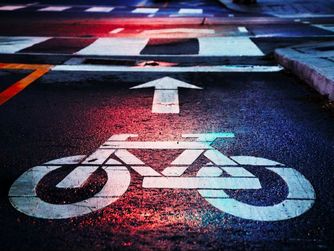Efficiency We all have limited time and are constantly trying to balance all the various aspects of our lives so even on a pleasantly sunny day, a time-pressed athlete including Coach can find themselves on trainers simply because it can be more efficient. Living in a city, it can take a while to get through the traffic and stop lights to actually get somewhere to ride without constant interruption. This can be fine for an easy recovery ride, a social ride or an extended warm up before a harder workout. When the workout calls for specific amounts of time in a harder effort, heart rate or power zone it can be hard to find a stretch of road that is conducive to the workout - not too many ups and downs, stop lights or other obstacles like dogs, strollers, kids and even cyclists. This is where the controlled environment of the trainer can be very useful. We can easily get in the harder efforts or even “hills” without interruption and thus gain the physiological benefits we are looking for. The time on a trainer, if ridden with intention, is estimated to be worth 1.5x the time on the road in terms of fatigue on your legs depending on sources. For most, when you are outside for a ride you spend more time than you realize coasting down a hill, slowing down for lights, corners or other stops. On a trainer, there is no coasting. There is never a rest break. Instead of coasting on the downhill, legs are constantly pedaling and your muscles are constantly working. For someone with limited time this can be a great way to actually spend less time and still get in the long ride or a specific ride. That being said, there does have to be intention behind the trainer workout to gain the benefits and be used in this way. Just sitting and pedaling easy with no change in effort or resistance is fine for active recovery. If we want to gain the benefits of a long run or uptempo workout there has to be intention in changing effort and pace just as you would if you were out on open road. The trainer is a controlled environment so an athlete can be precise in replicating intervals of a certain effort, rpm, heart rate or pace. The trainer is also great place to work on pedal mechanics and posture which we will talk about below. Pedaling Skills & Posture Riding on a trainer can give you a chance to work on pedaling skills and posture on the bike. We like to assign pedaling drills as there is no better way to assess what areas you need to work on in your cycling and to learn where your form breaks down. Cycling is a skill and needs to be practiced! A mirror near your trainer can be a great tool to see what your feet and legs are doing during a drill or what your posture does as you fatigue. Being able to maintain good form when tired will pay off huge no matter your event. Do you need to work on cadence? The trainer is a great place to concentrate on improving your cadence without the distractions of traffic. A higher cadence pedal stroke puts less strain on the muscle with each stroke thus improving your ability to remain predominantly aerobic over a various range of conditions. The goal is to aim for about 90 pedal strokes per minute. There are various cadence drills you can do to help with cadence. The goal is to improve the neuromuscular connection and learn to pedal quickly and smoothly without bouncing or rocking your hips. At first the higher cadence might feel awkward but over time it will feel more natural and help you ride longer with less fatigue. Do you mash on the down stroke instead of pedaling in a circle? There are many drills that will help you focus on various parts of the pedal stroke. Some focus on pulling up and others on the forward back motion of the stroke as the pedals come over the top or through the bottom. Some have you isolate one leg at a time. Try out several drills and see which ones work the best for you. The goal is to learn to apply power more effectively through the entire pedal stroke. Efficiency leads to more power! Mental Skills Bike trainers can be boring!! What a great time to work on those mantras and mental skills strategies to keep moving! Think about your breathing, your form, how to ride through discomfort. Listen to what background conversations come up and how you start to bargain with yourself and be ready to counter that negative background conversation. Have a plan for how long you want to ride and stick with it! Sometimes it is nice to not focus too and that can be a great way to catch up with a favorite tv show. To get a good workout in if you don’t have specific intervals assigned there are many games you can play. After a good warm up you can pedal at certain effort levels for various amounts of time or a certain number of pedal strokes, you can make imaginary hills or ride in your mind a ride you know and visualize the various landmarks as you go. Be creative and find ways to keep engaged on the trainer. These same mental gymnastics can help you when you are out on the road too! The Downsides As with any tool there are some downsides to riding the trainer and reasons this should not be the only form of riding you do if avoidable. Handling Skills One important aspect of riding that can not be developed when riding on a trainer is bike handling. Balance, braking, cornering, descending, avoiding or rolling over obstacles, riding close to other riders or traffic are all skills which take practice to develop. Coach Lesley feels strongly about the need for developing these skills and thus stresses the need for riding outside and often teaches an hour workout that is nothing but bike handling on the grass. The Static Position Another drawback to the trainer is the static position. With very little motion of the bike on a trainer, the rider uses fewer muscles to ride. The rider is not having to adapt to the lean of the bike around corners and up and down hills. Nor is the rider practicing getting in and out of the saddle and how that affects the center of gravity and handling of the bike. Some may find trainer rides challenging as the fixed position by using fewer muscles and the same muscles all the time can cause overuse issues particularly if you do not have a dialed in bike fit! Managing Terrain We often see that athletes need to have a better understanding and feel for when to shift and change up their pedal stroke when riding up and down hills. Have you ever gotten to the bottom of a hill and started up the other side and suddenly your legs are madly spinning with no resistance? Coach Lesley calls this “monkey legs” after an old toy that had a monkey on a bike with string legs and when you wound it up the legs would spin madly with the string wobbling about. When this happens, you are losing all your momentum and power right at the bottom of the hill and it will take more physical and mental work now to get up the hill. With some trainers that adjust the power an athlete can practice shifting but there is a certain amount of intuition and getting a feel for how to shift and adjust effort that can not be simulated on a trainer. Spin Classes No blog on indoor training is complete without the mention of spin classes at your local gym or now the technology to jump in a spin class almost anywhere in the world. These too can have a time and place. They can be great for motivation and a hard workout. They lack the specificity of riding your own bike, developing handling skills and doing a specific workout a coach has laid out for you but these too can be a great mix in to break up the boredom of indoor riding. A Helpful Training Tool Even though you may wish to only ride outside after the long winter, we hope you see that trainer rides have their uses year round. Yes there are pros and cons but hopefully we have inspired you to try something new on your trainer or learn how to use it as another tool in your training belt.
We love the ease of hopping on the trainer and doing a specific workout or watching a show while pedaling hard to nowhere! We hope you will too!
0 Comments
Leave a Reply. |
Categories
All
Archives
|


 RSS Feed
RSS Feed
